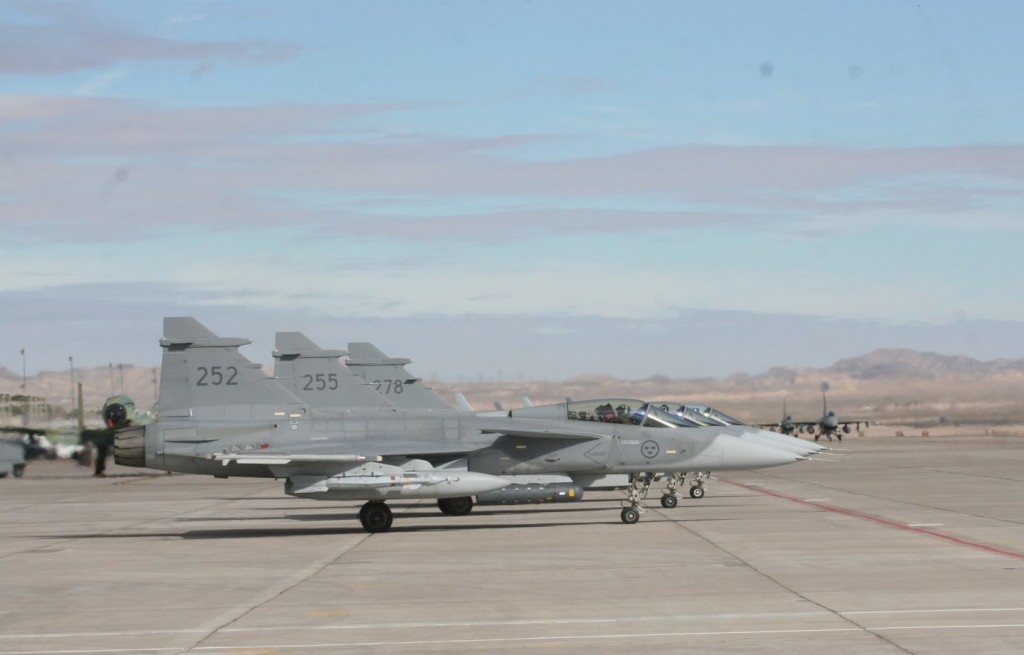Half the exercise is now done, but in terms of the number of training sessions, we have done a little more because it was ten flights this week and nine in the next week. We got one daylight and one night time session each day. We still follow our basic plan and fly with six aircraft each session. The reason we don't fly with all eight at the same time is because there must be spare aircraft if something should go wrong in the take off. If one our of pilots would be unable to start, it could have major implications for the entire practise operation, that is the COMAO (Composite Air Operations).
Now when the first week is completed, I can say that we have planned 60 flights. Six of these were canceled due to weather and two more because the pilot found some of the subsystems to have some slight glitches. Had we had the weather on our side, we would thus come up in almost 98% availability.
We have this week faced several challenging situations. The exercise is not structured like we are used to with a long campaign in which the "war" will evolve over time. This exercise is based instead on a number of set situations. These changes character and content every day. Prior to each flight session, a designated Mission Commander (MC) know what the purpose of the mission is, what the opponent is and what the political and military rules of action available allows for. The MC then allocated their resources which may be fighter, attack, bomber and reconnaissance and AWACS, tanker aircraft and SEAD (suppressing the air defense).
The MC make a plan for how he is to deal with the situation given to him by high command, to his help he got all available resources involved in the exercise, he obviously want to solve the task with as little own losses as possible. He will have full freedom to use our Swedish JAS (almost) for exactly what he wants. Therefore, we have during the past week served as both offensive fighters against enemy aircraft (OCA), escort duty for tactical airplanes and bombers and protected territory (DCA). Sweden has also had offensive attack roles (AI) and performed close air support (CAS). It is during the AI and CAS that we use live ammunition. We have also been chosen to act as MC on two occasions during the exercise. The first occasion was today, Friday. One of our young captains were during the day commanding more than 50 fighter and bomber aircraft. He was tasked to fight ground targets deep in the enemy territory of an opponent who possessed both modern fighters, mobile land units and advanced air defense units. Exactly how this session went, I hope that he will describe in a future post.
We have solved our tasks this week much as expected. Unfortunately, Nevada had a bit of bad weather on Thursday when we had the task of attacking ground targets with live bombs. Six different goals, all of which were linked to the opponent's leadership chain was tasked for an attack, but clouds and visibility was that we came into conflict with the weather limits set for the exercise. Because of the complex planning that the MC does, there was not time to reschedule to solve another task. Besides the weather at this particular session we have only had minor problems during the week.
How has it gone? When we practice, we look at a number of things that we want to evaluate. Top priority is safety, but we also evaluate our own losses, enemy losses, incorrect attacks (fratricide), damage to the third party (collateral damage), rules of engagement (ROE) and obedience to the laws of war. As regards to safety, I can happily say that our pilots are doing excellent. We practice at a very high level, but we do it within the established limits. We have not received any complaints on our way to fly. Own losses? Well, unfortunately, the enemy have succeeded at a couple of times, both from the air and from the ground, but to a very limited extent. However, we have repeatedly been able to combat enemy fighters and we managed to reach our ground targets without the risk of a third party. We have gotten around 10 kills for each of our own losses. We have also managed to attack our targets under current ROE.
What do we learn? The exercises are very complex with a large amount of opponents. The pilot learns to handle aircraft, weapon systems and countermeasure systems in a better way which increases the chance for survival and action. The other big lesson is cooperation with other nations and units. Our pilots have to understand, for example, Mirage 2000, F-15, F-16, F-18, B-52 and F-22 abilities and shortcomings in order to achieve maximum effect. To help them, the pilot also our MSE (Mission Support Element) that after each pass adjusts electronic warfare libraries and countermeasures so that the pilot should have better warning against threats.
The whole thing is a bit like gathering together a football team. All the players are professionals, but they need some friendlies together to become an effective team. This week, the Blue team played some friendlies against the Red. Next week is the qualifying and finals. Expect that there are some Swedish players who want to win the match.
Anders Segerby
Contingent Head SWAF Red Flag



 Recent Blue Posts
Recent Blue Posts
 Recent Forum Posts
Recent Forum Posts
 New heritage armors (Draenei and Troll) are not acceptable
New heritage armors (Draenei and Troll) are not acceptable MMO-Champion
MMO-Champion



 Reply With Quote
Reply With Quote
